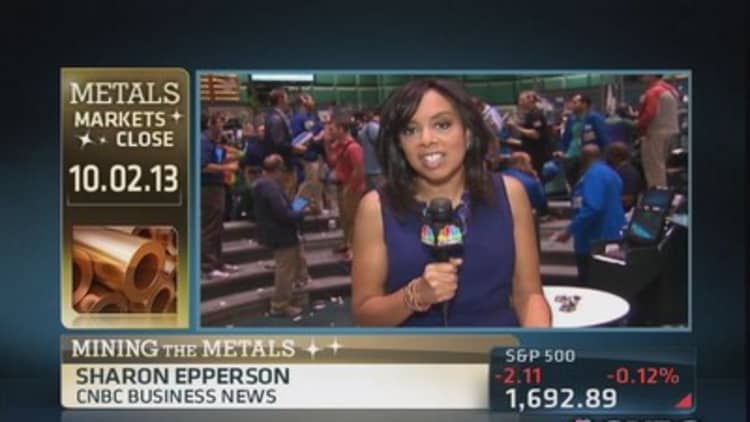The dollar has been in a funk and is not likely to shake it until Washington resolves the budget and debt ceiling crises.
"Clearly the dollar is not really playing that much of a safe-haven role through this latest episode," said Vassili Serebriakov, currency strategist at BNP Paribas.
The greenback has been on a course lower since just around Sept. 6, the day the disappointing August jobs report was released, showing just 169,000 jobs created. That was the last major piece of data received by the Fed before its September meeting, when it decided to continue full throttle with its bond-buying program, a negative for the dollar.
(Read more: Euro thrives as ECB's Draghi stays course; dollar struggles)
The market then focused on the Sept. 30 deadline by which Congress needed to fund the government, weakening the dollar further. Congress failed to meet that deadline and the government shutdown Tuesday has created new anxiety about how the closure will affect the economy and whether Congress will step up to resolve it and the much thornier issue of the debt ceiling.

"The longer uncertainty drags out, the more of an economic impact it has and the more I think market participants will see implications for Fed policy, pushing back tapering. It should continue hurting the dollar and I think it's going to continue to grind lower," said Serebriakov.
Goldman Sachs economists said the government shutdown, including the layoff of 800,000 workers, could shave 0.25 to 0.5 percent off of fourth quarter GDP if it lasts two weeks. The same amount could be added to the first quarter, as government activity resumes.
The dollar has been weaker against currencies that are considered more safe haven, like the Swiss franc, the euro and sterling, but stronger against emerging market currencies and the Australian and New Zealand dollars. Since early September, the dollar index has lost 3.3 percent and was trading at 79.8 on Wednesday, an eight-month low.
Marc Chandler, chief currency strategist at Brown Brothers Harriman, said the uncertainty is keeping some investors sidelined. "Many want to wait until we get past the debt ceiling. ... For the most part, they're not really committing a lot of resources until the situation clarifies," he said. "It could be scary going into it (the debt ceiling) because the two crises are going to blend into each other."
The U.S. is expected to hit the $16.7 trillion debt limit Oct. 17, and while the White House is pushing for it to be raised, many Republicans are against it.
"There's little reason to want to own the dollar at this point, given all the political risk and uncertainty around it until Washington comes to some kind of resolution," said Boris Schlossberg, managing director with BK Asset Management. "What's happening now is we have a financial crisis that could turn into a Constitutional crisis. The conflagration of the two points is starting to get the markets on edge. They really thought this was going to be resolved through negotiation."
Markets had underestimated the ability of Washington to end up at an impasse. Many analysts and traders had thought politicians would keep the government from shutting down, but now they are becoming concerned that it will not be a quick shutdown because the spending resolution will become part of a bigger battle over the debt ceiling.
There is also growing concern that there will be no compromise on the debt ceiling, and President Obama may then raise it without Congressional support to avoid a default, triggering lawsuits.
Serebriakov said it's not clear what would happen if the U.S. reached the debt limit. He said it could trigger a flight-to-safety reaction, just as the Standard and Poor's downgrade of the U.S. AAA credit rating did two years ago.
(Read more: Get out the rally hats: Shutdowns are bullish!)
Chandler said the dollar, however, is sending an important message, and that is that investors do not expect a worst case scenario. It would be much weaker if investors really believed the U.S. could hit the debt ceiling or that Congress would allow a default to occur.
But until the situation is resolved, "It stays on edge. It keeps some players on the sidelines, it affects liquidity and it's nervous, which means there could be sharp moves on nothing. This is short-term noise," Chandler said.
Besides the weaker dollar Wednesday, stocks were on edge, after ignoring the shutdown Tuesday. The Dow was off 58 at 15,133 and the S&P 500 was off 13 at 1693.
Chandler said the shutdown makes it less likely the Fed will pare back its $85 billion bond purchase program this year. That also could be weighing on the dollar, since quantitative easing is a negative for the dollar.
Traders had been hoping the monthly jobs data, an important metric for the Fed would send a signal as to whether the Fed would move toward tapering at its Oct. 30 meeting. Instead, the data is likely to be delayed and they will instead focus on the economic reports that are available. The government will continue to issue weekly jobless claims data.
Claims are released at 8:30 a.m. ET Thursday, and there will also be the Institute of Supply Management's non-manufacturing survey at 10 a.m. .
—By CNBC's Patti Domm. Follow her on Twitter @pattidomm.


